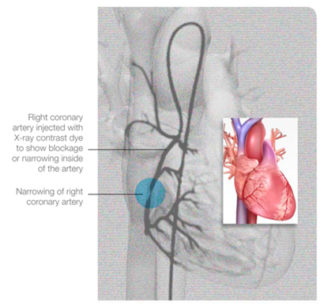What Is a Coronary Angiogram?

The coronary arteries supply your heart muscle with blood. They can become clogged from a buildup of cholesterol, cells or other substances (plaque). This can reduce the flow of blood to your heart. If a blood clot forms and blocks blood flow through that artery, a heart attack may occur.

Why do I need this test?
A coronary angiogram is a special X-ray test. It’s done to find out if your coronary arteries are blocked or narrowed, where and by how much. An angiogram can help your doctor see if you need treatment such as angioplasty or stent, coronary artery bypass surgery (CABG) or medical therapy.
Procedures aren’t necessary for all blockages. Sometimes all you need to do is take medicines and:
- Lower your blood pressure
- Stop smoking
- Lower your cholesterol
- Eat a healthy diet
- Stay physically active
What happens during an angiogram?
- You may be given medicine to relax you, but you will stay awake.
- You go to the hospital’s heart catheterization laboratory (“cath lab”).
- You lie on a table near a camera and other equipment
- Your doctor numbs a spot on your groin or arm and inserts a thin tube (catheter) into an artery and up to the heart. This will hurt no more than a blood test.
- Special fluid goes through the catheter so arteries show up well on the X-ray
- X-rays are taken as the fluid goes through the artery
- You may be asked to hold your breath or cough
- By studying the X-ray images, the doctor can see any problems with your coronary arteries
- If you wish, you can see the X-ray pictures on the screen during or after the test.
What might I feel?
- Slight pressure as the catheter is put in
- Rarely, some chest discomfort as the fluid goes in
- An urge to urinate
- Rarely, nausea
- If a picture of the heart’s main pumping chamber is taken (and it’s taken during about 2/3 of angiograms), you’ll feel a hot flash sensation from head to toe that will last for 20 seconds as the special fluid is injected.
- During the angiogram, you’ll be awake so you can do as your doctor asks.
What happens after the test?
- The catheter will be taken out.
- A nurse or doctor will apply direct pressure for 15 minutes or longer where the catheter was inserted to make sure there is no internal bleeding.
- You will be asked to lie quietly on your back for several hours. You won’t have to lie on your back if the catheterization was performed from an arm artery.
- You will go back to your hospital room or Cardiac Care Unit (CCU).
- You may feel sore where the catheter was inserted or from lying on your back.
- Your doctor will talk to you about the results.
The procedure is typically performed in a hospital setting and requires the patient to lie still on an X-ray table while the images are captured. While there are some risks associated with the procedure, it is generally considered safe and effective for diagnosing heart conditions.
If you have been experiencing symptoms of a heart condition or have been diagnosed with one, your doctor may recommend a coronary angiogram to help determine the best course of treatment. It is important to discuss the risks and benefits of the procedure with your healthcare provider to determine if it is the right choice for you.

